12 Thoracic Outlet Syndrome Exercises for Lasting Relief
Thoracic outlet syndrome occurs when nerves or blood vessels become compressed in the area between the clavicle (collarbone) and first rib. This space is known as the thoracic outlet. Symptoms of thoracic outlet syndrome can include the following:
- Arm pain
- Back aches
- Cold hands and fingers
- Neck pain
- Numbness in upper extremities
- Swelling in the arms, hands, or fingers
- Tingling or pins and needles sensation in the hands and fingers
- Weakness in the shoulders, neck, arms, or hands
Once TOS has been diagnosed by a healthcare professional and any acute pain is under control, exercises and stretches are the next step in treatment. Certain exercises can help alleviate those suffering from TOS.
Is stretching good for thoracic outlet syndrome? Stretching is good for TOS. Many of the exercises below are stretches. You’ll want to visit a physical therapist or chiropractor before trying strenuous movements. They can help you build an exercise program based on your specific needs.
While the majority find stretching and strengthening helpful, symptoms may worsen for those who have other conditions. That’s another reason it’s important to discuss new exercises with a professional.
TOS exercises focus on 3 areas: the neck, the upper back, and the chest. Stretching muscle groups in these areas should help relieve the tension and pressure causing impingement in the thoracic outlet.
We’ve compiled a list of stretches and exercises that both strengthen and improve range of motion.
1. Scapular Rotations
This stretch exercises the muscles around the scapula, or the shoulder blade.
Starting position: Stand with the arm of the affected side outstretched in front of you.
- Lift (elevate) the shoulder while keeping the arm straight
- Pull the shoulder back (retraction) still keeping the arm straight
- Lower (depress) the shoulder continuing to keep the arm straight
The goal is basically to make circles with your shoulder.
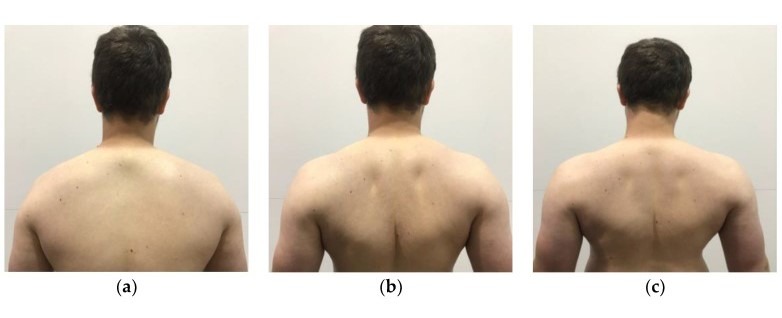
Reps: 5
Sets: 3
2. Frontal and Lateral Raise
Frontal and lateral raises require small weights, such as 1-5 lb dumbbells. Frontal raises work the shoulders (anterior deltoids), the upper back (trapezius muscle), and parts of the pectorals.
Starting position: Stand with knees slightly bent and with hands gripping the individual dumbbells. Your knuckles should face away from you.
- Slowly and smoothly lift the dumbbells directly in front of you, no higher than your eyes
- Hold for 3 seconds
- Slowly and smoothly lower the dumbbells to starting position
Lateral raises also work the shoulders and upper back. This latter exercise is quite similar to the former, except your arms raise from the sides rather than the front. Starting position is taking a dumbbell in each hand, with knuckles facing out, and standing with your arms by your sides.
- Lift the weights until you reach the height of your shoulders
- Hold for 3 seconds
- Lower the weights to the starting position
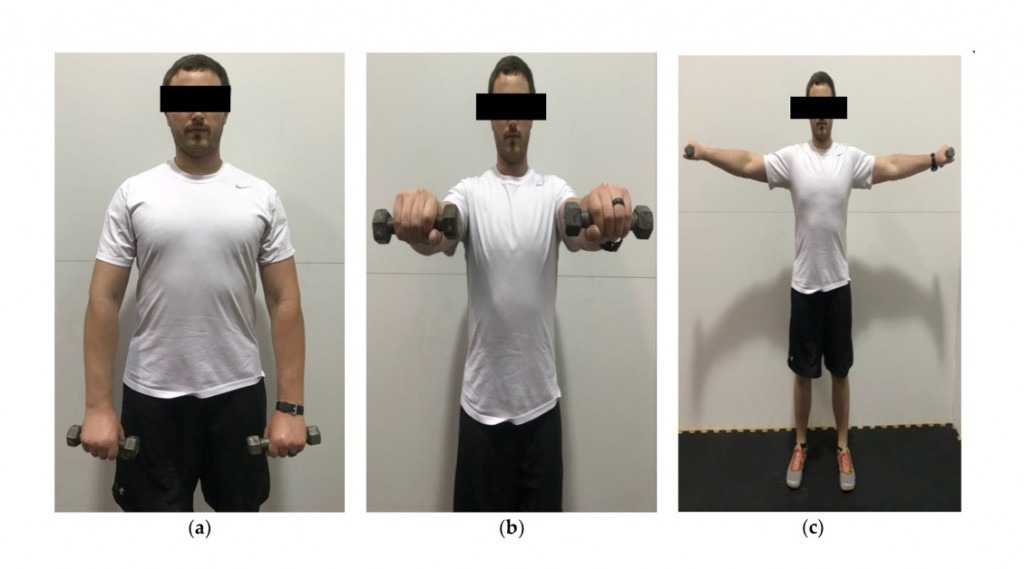
Reps: 5-10
Sets: 3
3. Nerve Gliding/Flossing
One study found nerve gliding crucial to conservative and surgical forms of treatment for TOS. Nerve gliding is the gentle technique of stretching nerves, as you might sore muscles, to reduce irritation.
The ulnar nerve running down the arm is often responsible for tingling sensations. The ulnar nerve glide should help relieve this TOS symptom. Starting position is standing while making the “O.K.” sign with the fingers of the affected arm.
- Place your hand on your face so that the circle created by your index finger and thumb is over your eye (creating a sort-of monocle)
- The elbow should be high and the arm should form a triangle
- Slowly take your hand away from your face and outstretch your arm, all the while holding the O.K. sign
- Tilt head away from the outstretched arm
Reps: 15
Sets: 2
4. Standing External Rotations
This exercise works the infraspinatus muscles. It requires a band and a towel. Anchor the band to a doorknob and place the towel between your side and the affected arm. Starting position is gripping the band with your arm at a 90 degree angle.
- Slowly pull band away from the body, while holding the towel in place
- Hold briefly
- Slowly return arm to the starting position
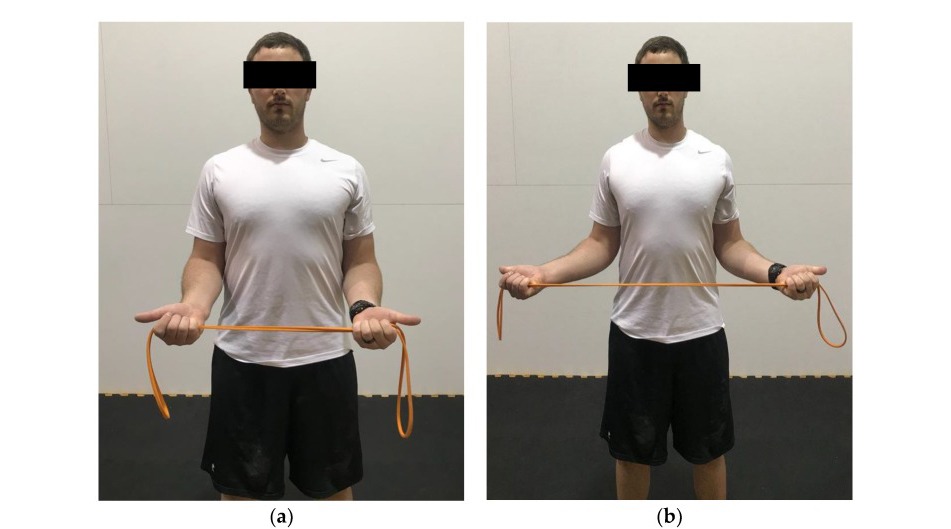
Reps: 10
Sets: 3
5. Serratus Push
This exercise activates the serratus muscles which cover the sides of the ribs. When is action, this exercise appears to be mini push-ups. Starting position is on hands and knees as though you were performing a modified push-up.
- Do a chin tuck to get your head in the optimal position
- Lower towards the ground, allowing scapular muscles to lead the movement
- Push the ground to lift to the starting position
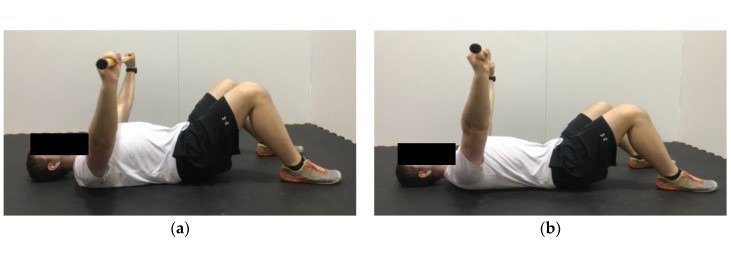
Reps: 8
Sets: 2
6. First Rib Mobilization
The first rib is an atypical (shorter and structured differently) rib that can become elevated out of place. Mobilizing it or getting into its original position can relieve compression of the nerves and blood vessels in the thoracic outlet.
Starting position is sitting in a chair with the back straight. A strap lies over the affected side’s shoulder.
- Pull strap towards the opposite hip
- Tilt the head to the side, towards the affected side
- Look down towards your upper arm
- Hold for about 20 seconds
Reps: 4-5
Another way to free up your first rib requires a massage or lacrosse ball. Find the space or “pocket” just beneath the collarbone where the first rib lies. Take the ball and press down on the first rib. Feel free to apply quite a bit of pressure, but not so much that it’s painful. Breathe in deeply then release that breath.5
7. Banded Straight Arm Extension
This exercise stretches scapular musculature. A stretchy band is required for this exercise. Starting position is a relaxed standing position with both hands gripping the band.
- Pull the band in opposite directions as far as possible
- Focus on using your scapular muscles to help the pulling
- Push your chest out
- Gently return to the starting position
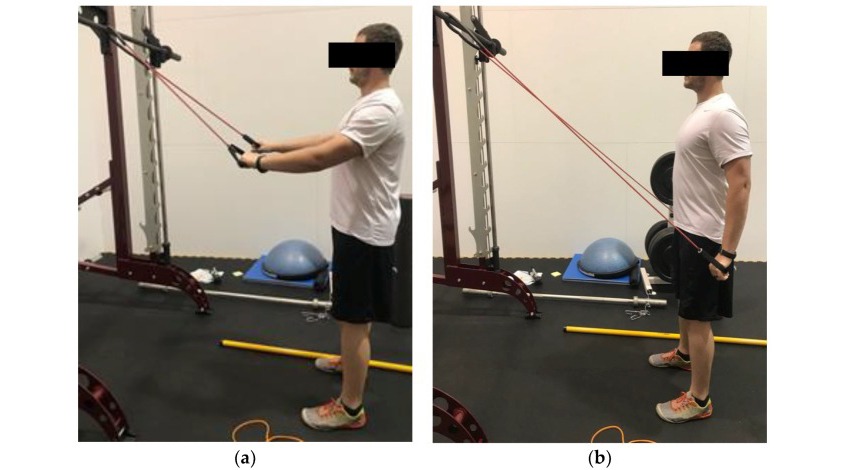
Reps: 4
Sets: 3
8. Pec Minor Stretch
The pectoralis minor stretch is meant to open up the chest muscles and the rib cage. A foam roller is required for this particular exercise. Starting position is lying on your back on top of the foam roller. Be sure your neck and head are supported by the foam roller. Feet are flat on the ground with knees bent.
- Spread your arms out to your sides with palms up and let them fall to the floor (you’ll feel the stretch in this starting position)
- Slowly move arms up or down to find different positions that stretch different areas of your pecs
When you find a good stretch position, hold it for about 30 seconds, then give yourself a break.
Reps: 4
An additional, simple pec exercise that you can do standing or sitting is clasping your hands behind your back and pushing your chest out. Try to keep your palms touching. Hold for 30 seconds 3 times.
9. Chin Tuck
This may be the easiest exercise in our list. It stretches muscles that connect to the cervical spine.
- Sit in a chair and make sure your posture is good- straight back (not slouched) with shoulder back and down
- Pull your head back
- Hold for about 10 seconds then relax
Think about it like you’re trying to create a double chin. We avoid that look at all costs; however, it’s the goal for this exercise.
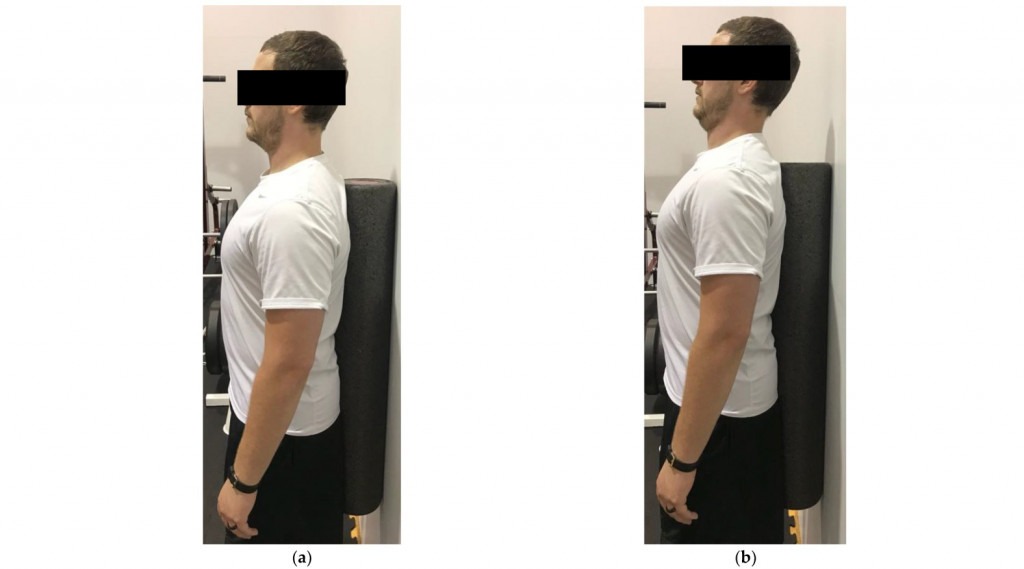
Reps: 6-8
10. Thoracic Spine Foam Rolling
This stretch is great for helping to correct poor posture and aid thoracic extension. A foam roller is required. Starting position is sitting on the ground with the foam roller situated perpendicular to the spine. The foam roller should be placed at the base of the thoracic spine.
- Grasp a stick of sorts with both hands
- Extend arms as far above and behind your head as possible
- Try to touch the floor with the stick
- Keep bottom on the floor
- Hold the position for 20 seconds
Reps: 3
11. Shoulder Extension with Abduction
This exercise stretches the shoulder muscles and requires a stick or cane. Starting position is standing while both hands grip the stick behind you.
- Lift the stick up and away from your bottom as far as possible
- Slowly lower the stick to starting position
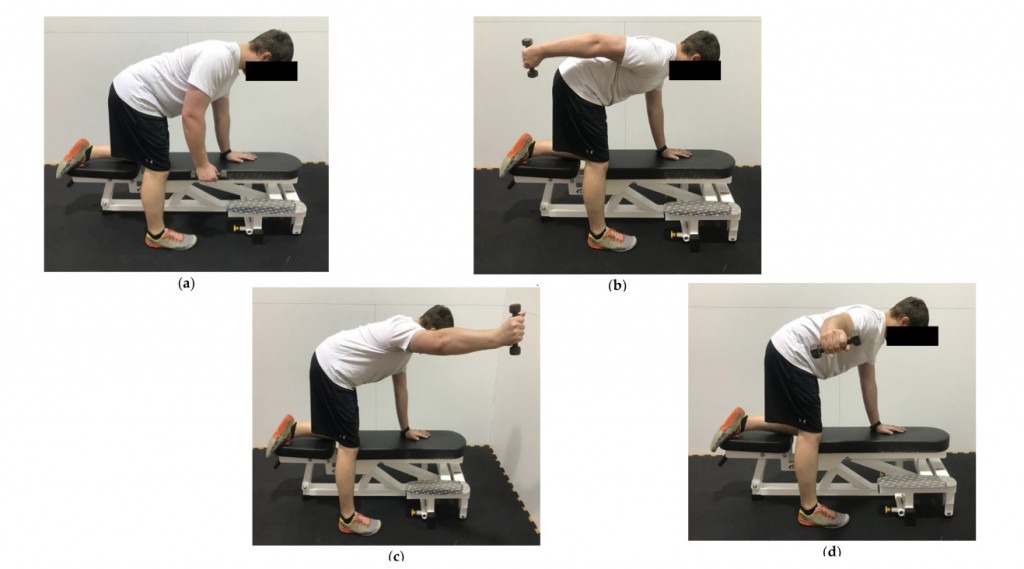
Reps: 10
12. Scalene Muscle Stretch
This neck stretch aims to alleviate stress on the blood vessels and nerves located in the interscalene triangle (the first rib forms the base and the anterior and middle scalenes form the sides). Starting position is sitting in a chair with the back straight. A strap lies over the affected side’s shoulder.
- Pull strap towards the opposite hip
- Tilt the head to the side, away from the affected side
- Slightly turn your face towards the affected side
- Tuck the chin gently
- Hold for about 30 seconds
Reps: 5
Types of TOS
The 3 types of TOS include
- Neurogenic TOS- the brachial plexus nerves in between neck muscles (posterior and anterior scalenes) become compressed. It’s quite treatable via physical therapy. This is the most common form of TOS.
- Venous TOS- the subclavian vein becomes compressed as it passes through the costoclavicular space. It affects about 10% of TOS patients.
- Arterial TOS- the subclavian artery becomes compressed which can cause serious blockages or aneurysms. Affecting about 1% of TOS patients, it is the rarest form of TOS.
Sometimes venous and arterial TOS are together referred to as vascular TOS. While neurogenic TOS symptoms can be addressed with exercises and sometimes medication, vascular TOS is more serious and may require surgery to correct.
What causes TOS?
Several things could cause neurogenic thoracic outlet syndrome including
- Congenital abnormalities such as a cervical rib
- Injury or trauma
- Poor posture
- Competing in sports
- Repetitive use of arms overhead
What aggravates thoracic outlet syndrome? Overuse or incorrect use of muscles surrounding the thoracic outlet or a poor sleeping position could aggravate thoracic outlet syndrome.
If you’re uncertain about whether or not you can safely do these exercises or if your symptoms are more severe in nature, don’t hesitate to seek medical advice from a trusted healthcare provider.
Ready to get to the root of your problem with chiropractic care? We’re currently accepting new patients at our Ball Ground and Atlanta/Decatur offices.
Sources
- Hanif, S., Tassadaq, N., Rathore, M. F. A., Rashid, P., Ahmed, N., & Niazi, F. (2007). Role of therapeutic exercises in neurogenic thoracic outlet syndrome. Journal of Ayub Medical College Abbottabad, 19(4), 85-88. Abstract: https://pubmed.ncbi.nlm.nih.gov/18693607/
- Crosby, C. A., & Wehbé, M. A. (2004). Conservative treatment for thoracic outlet syndrome. Hand clinics, 20(1), 43-49. Abstract: https://pubmed.ncbi.nlm.nih.gov/15005383/
- Kenny, R. A., Traynor, G. B., Withington, D., & Keegan, D. J. (1993). Thoracic outlet syndrome: a useful exercise treatment option. American Journal of Surgery, 165, 282-282. https://pubmed.ncbi.nlm.nih.gov/8427413/
- Novak, C. B., Collins, E. D., & Mackinnon, S. E. (1995). Outcome following conservative management of thoracic outlet syndrome. The Journal of hand surgery, 20(4), 542-548. https://pubmed.ncbi.nlm.nih.gov/7594276/
- Levine, N. A., & Rigby, B. R. (2018, June). Thoracic outlet syndrome: biomechanical and exercise considerations. In Healthcare (Vol. 6, No. 2, p. 68). MDPI. https://www.ncbi.nlm.nih.gov/pmc/articles/PMC6023437/
- Wehbé, M. A., & Schlegel, J. M. (2004). Nerve gliding exercises for thoracic outlet syndrome. Hand clinics, 20(1), 51-55. https://pubmed.ncbi.nlm.nih.gov/15005384/


